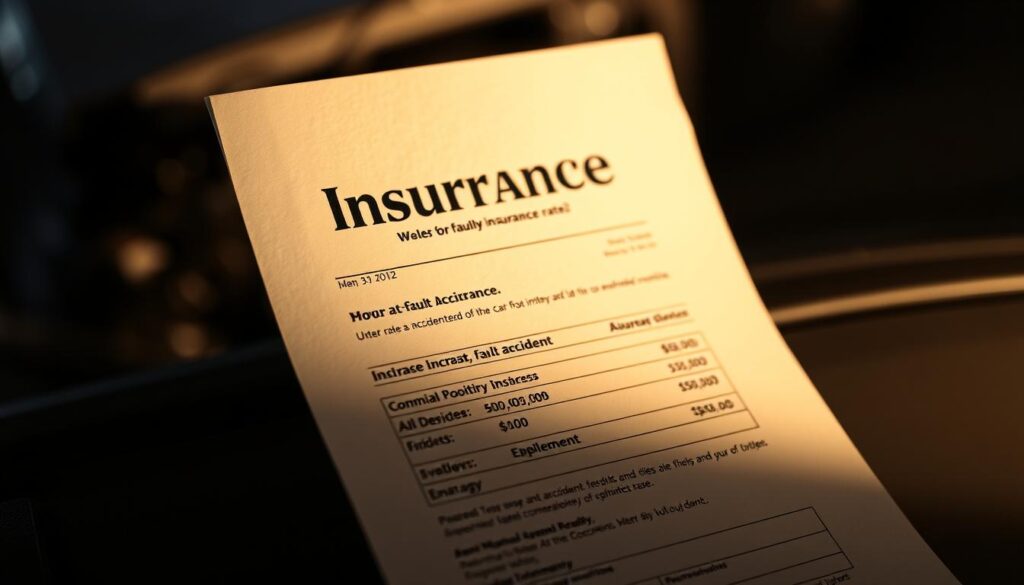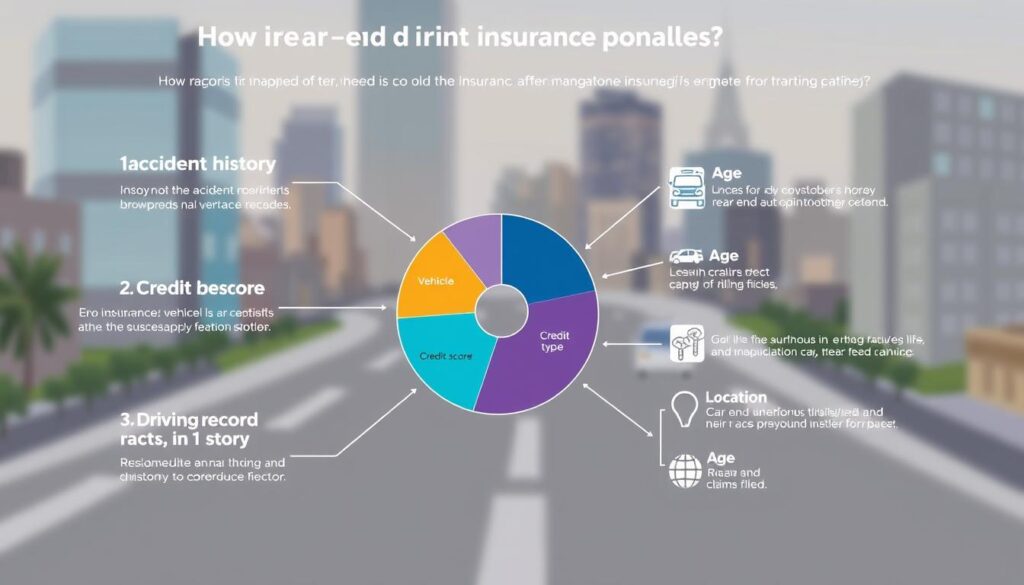Being in a rear-end collision can be very stressful. It often makes people worry about how it will affect their insurance rates. They wonder if they were at fault and how this affects their insurance premiums.
It’s important to know how an at-fault accident can change your insurance. Insurance companies look at your driving record and the accident details. They use this to figure out how much risk you are as a driver.
Key Takeaways
- Being involved in a rear-end collision can impact your insurance rates.
- Fault determination plays a significant role in how insurance rates are affected.
- Insurance companies assess your driving record and accident circumstances.
- Understanding your insurance policy can help manage rate increases.
- Some insurance providers offer accident forgiveness programs.
Understanding Fault in Rear-End Collisions
Knowing who’s at fault in rear-end collisions is key for handling insurance claims. Usually, the driver who hits another car from behind is seen as at fault.
Why Rear-End Collisions Usually Result in At-Fault Claims
The driver who hits another car from behind is often blamed because they should keep a safe distance. Not doing so often leads to them being at fault.
Exceptions to the Presumption of Fault
But, there are times when the car hit from behind might share or be fully at fault. This can happen if the other driver stopped suddenly without reason or if their brake lights didn’t work.
Comparative Negligence in Some States
In some places, the law splits fault based on how much each side was careless. This changes how insurance claims are handled and settled.
For example, if someone is hit from behind but was also partly to blame, they might get some compensation. It’s important for drivers to understand these rules after a rear-end crash.
Immediate Steps to Take After Rear-Ending Another Vehicle
After a rear-end collision, staying calm is key. Follow the right steps to keep yourself safe and make the insurance claims easier.
Safety First: Securing the Scene
First, make sure everyone is safe. Move to a safe spot if you can. Turn on your hazard lights to warn others.
Check for injuries and help if you can. Your safety is the most important thing.
Documenting the Accident Properly
It’s important to document the accident scene well. Take photos of the damage and the area. Also, capture any road signs or signals.
Remember to note the time, date, and weather. This helps a lot with the insurance claims.

Communicating with the Other Driver
When you talk to the other driver, share your contact and insurance info. Be friendly and helpful, but don’t say you were at fault.
When to Contact Your Insurance Company
Call your insurance right after the accident. They’ll help you with the claims and tell you what you need to do.
| Immediate Action | Purpose |
|---|---|
| Secure the Scene | Ensure Safety |
| Document the Accident | Facilitate Insurance Claims |
| Exchange Information | Enable Communication |
| Contact Insurance Company | Initiate Claims Process |
How Insurance Companies Process Rear-End Collision Claims
After a rear-end collision, knowing how insurance handles claims is key. The process has several steps that shape the claim’s outcome.
The Claims Investigation Process
Insurance companies start by investigating the accident. They collect evidence, look at police reports, and check the damage. This phase is vital for understanding the accident.
Determining Liability and Damages
Next, they figure out who’s at fault. Then, they look at the damages, like car repairs and medical bills. Getting damages right is key for a fair settlement.
Timeline for Claim Resolution
The time it takes to settle a claim varies. It depends on the case’s complexity and the insurance’s efficiency. Insurers try to be quick but fair.
Initial Assessment Phase
In the first step, insurers check the claim and might ask for more info. This phase is important for starting the claim process.
Settlement Negotiation Phase
After checking the claim, talks start to agree on a settlement. This is when the insurer and claimant work together. 
I Rear-Ended Someone: How Much Will My Insurance Go Up?
If you’ve rear-ended someone, you might be worried about your insurance costs. The increase can be big, but it depends on many things.
Average Premium Increases After At-Fault Accidents
Drivers usually see their insurance go up by 40% to 50% after an accident. This is because insurers see accidents as a sign of higher risk.

State-by-State Variation in Rate Increases
Insurance rate hikes vary a lot by state. Some states have strict rules that limit how much rates can go up. Others let insurers raise rates more.
Duration of Premium Surcharges
Premium surcharges from an accident usually last three to five years. This means your yearly premiums will be higher for a while.
First-Time Accident vs. Multiple Accidents
The effect on your insurance also depends on if it’s your first accident or not. Drivers with no previous claims might see a smaller increase than those with accidents on their record.
Key Considerations:
- Your insurance company’s policies regarding at-fault accidents
- State laws and regulations concerning insurance rate increases
- Your driving history and previous claims
Knowing these factors can help you prepare for and maybe lessen the impact of a rear-end collision on your insurance.
Factors That Determine the Size of Your Rate Increase
Knowing what affects your insurance rate after a rear-end collision is key. Many things influence how much your premium might go up.
Your Driving History and Prior Claims
Your driving record is a big factor. If you’ve had accidents or tickets, you might see a bigger rate hike. But, a clean record can help keep your rates lower.
Severity of Damages and Injuries
The damage and injuries from the accident matter too. More serious accidents can lead to higher claims. This can cause a bigger jump in your insurance costs.

Your Insurance Company’s Specific Rating System
Every insurance company has its own way of rating you. They look at your driving, the accident’s severity, and more. Knowing how your company rates can help you understand rate increases better.
State Insurance Regulations
State laws also affect rate increases. Some states cap how much rates can go up after an accident. Others have looser rules.
Your Current Premium and Coverage Level
Your current premium and coverage level matter too. Higher coverage or premiums might lead to different rate changes than basic plans.
Understanding these factors can help you deal with rate increases better. It might even help you keep your premiums lower.
How to Minimize the Impact on Your Insurance Premiums
After a rear-end accident, you might worry about higher insurance costs. But, there are steps you can take to keep costs down. Understanding your options and acting early can help a lot.
Accident Forgiveness Programs
Accident forgiveness programs can help avoid premium hikes. These programs, offered by some insurers, keep your rates steady after your first accident. Check if your insurer offers this and know the details.
Defensive Driving Courses
Taking a defensive driving course can improve your driving and lower your premiums. Insurers see these drivers as less risky. Choose courses approved by your state’s DMV or insurance agency.
Adjusting Coverage Options
Reviewing your coverage can also help. You might drop coverage you don’t need or lower limits. But, make sure you have enough coverage to protect yourself.
Exploring Available Discounts
Insurance companies offer discounts that can reduce your premium. These might include bundling policies, good credit, or driving less. Ask your insurer about discounts you might qualify for.
Raising Your Deductible Strategically
Increasing your deductible can lower your premium. But, make sure you can afford the deductible if you need to file a claim. Find a balance between deductible and premium costs.
By using these strategies, you can lessen the effect of a rear-end accident on your insurance. It’s all about being proactive and making smart choices about your coverage.
When to Consider Switching Insurance Providers
After a rear-end accident, it’s key to think about changing your insurance. The crash can raise your rates. Look for better rates or services that fit your new situation.
Comparing Post-Accident Rates Across Companies
Start by comparing rates from different insurers. Shopping around can reveal cheaper options, even after an accident. Use online tools or talk to agents to get quotes from various companies.
Timing Your Switch Strategically
When to switch is important. It’s best to change at policy renewal to avoid penalties for early cancellation. But, a better deal might make switching mid-policy worth it.
What to Disclose to New Insurers
Be open with your new insurer about the accident. Transparency about your driving history and claims is key. It ensures your new policy is fair and avoids future claim issues.
Companies That Specialize in Higher-Risk Drivers
Some insurers focus on high-risk drivers, like those with accidents. They might offer better rates or more flexible rules. Finding these companies can help if you’re struggling to find affordable insurance after an accident.
Long-Term Effects on Your Insurance Record
After a rear-end collision, your insurance record can be affected for years. It’s important to know how this works to manage your insurance well.
How Long Accidents Stay on Your Record
Accidents usually stay on your record for three to five years. This depends on your state’s laws and your insurance company’s rules. During this time, your insurance costs might go up.
Impact on Insurance Score and Future Rates
An accident can lower your insurance score, making your premiums higher. Your insurance score shows how likely you are to file a claim. A lower score means you’ll pay more when your policy renews.
Insurance Score Factors:
- Claims history
- Credit history
- Payment history
- Length of credit history
Rebuilding Your Insurance Profile
To lessen the long-term effects, work on improving your insurance profile. Here’s how:
- Keep a clean driving record
- Pay your premiums on time
- Check your credit score
When You Might Need SR-22 Filing
After a serious accident, you might need to file an SR-22 form. This is usually needed if you’ve been convicted of a serious driving offense or had your license suspended.
| State | SR-22 Requirement | Duration |
|---|---|---|
| California | Mandatory after DUI | 3 years |
| Florida | Required after multiple offenses | 2-3 years |
| Texas | Necessary for certain convictions | 2 years |
Knowing how a rear-end collision affects your insurance record helps you act. You can take steps to lessen the impact and improve your insurance profile over time.
Preventing Future Rear-End Collisions
To stop rear-end collisions, drivers need to be careful and use safety tech. A few simple steps can lower the chance of being in such accidents.
Defensive Driving Techniques
Defensive driving is key to avoiding rear-end crashes. It means knowing what’s around you, guessing what others might do, and keeping a safe distance. Being alert and focused helps you avoid accidents.
Technology That Can Help
Today’s cars have tech to help prevent or lessen the impact of rear-end crashes. Forward Collision Warning (FCW) and Automatic Emergency Braking (AEB) systems warn drivers of danger and can even stop the car if needed.
Maintaining Safe Following Distances
Keeping a safe distance is a simple yet effective way to avoid rear-end crashes. Aim for a 3-second gap with the car in front. This gives you enough time to stop if needed.
Weather Considerations and Adjustments
Weather affects road safety a lot. Rain, snow, and fog make it harder to see and stop. Slow down and increase your gap based on the weather to stay safe.
| Weather Condition | Recommended Action |
|---|---|
| Rain | Reduce speed, increase following distance |
| Snow | Use low gear, avoid hard braking |
| Fog | Use low-beam headlights, reduce speed |
Conclusion: Managing the Financial Impact of Rear-End Collisions
Being in a rear-end collision can really raise your insurance costs. It’s important to know how to handle this to keep your insurance affordable.
First, you need to understand the insurance process and act fast after an accident. This means documenting the accident well, talking to the other driver, and calling your insurance right away.
Long-term strategies can also help lower your insurance costs. You might look into accident forgiveness, take defensive driving courses, or adjust your coverage to save money.
Being proactive and informed can lessen the financial hit of a rear-end collision. Make sure to check your insurance policy and look for ways to avoid higher rates after an accident.
To manage the financial impact well, you need a full plan. This includes knowing how your insurance company rates you and understanding state insurance laws. By controlling these, you can deal with the financial effects of a rear-end collision better.
FAQ
Will my insurance rates go up if I rear-end someone?
Yes, being at fault in a rear-end collision can increase your insurance rates. It’s seen as a risk factor for the driver.
How long will a rear-end collision stay on my insurance record?
The time an accident stays on your record varies. It’s usually between three to five years, depending on the state and insurer.
Can I prevent my insurance rates from increasing after a rear-end collision?
While accidents often raise rates, there are ways to lessen the impact. You can use accident forgiveness programs, take defensive driving courses, or adjust your coverage.
What factors determine how much my insurance will increase after a rear-end collision?
Several factors affect the rate increase. These include your driving history, the accident’s severity, your insurer’s rating system, state laws, and your current premium and coverage.
Should I switch insurance providers after being involved in a rear-end collision?
Switching insurers might help if you find a better rate. But, compare rates carefully. Consider the timing and what you must disclose to your new insurer.
How can I rebuild my insurance profile after a rear-end collision?
To rebuild your profile, drive safely and avoid accidents. Consider defensive driving courses. Also, make sure you’re getting all discounts from your insurer.
What is an SR-22 filing, and when might I need it?
An SR-22 is a certificate needed for drivers in certain accidents or violations, like DUIs or multiple accidents. You might need it for serious accidents.
Can technology help prevent rear-end collisions?
Yes, safety features like automatic emergency braking and forward collision warnings can greatly reduce the risk of rear-end collisions.
How do state insurance regulations affect my rate increase after a rear-end collision?
State laws can influence how insurers raise rates. Some states cap rate increases or have rules about using accidents in premium calculations.
